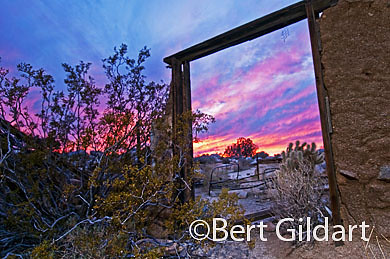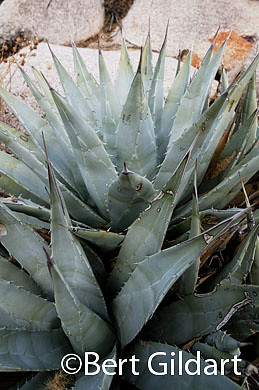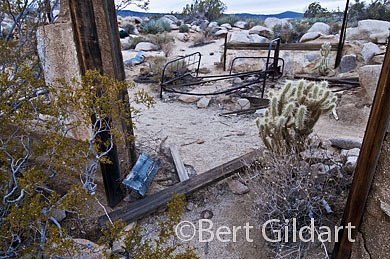At Yaquitepec, Atop Ghost Mountain In Anza Borrego, January of 1940 Was a Very Good Year
©Bert Gildart: “It was probably a little something like this,” said Bill D., who has become a student of the years Marshal South, Tanya, and their three children spent atop Ghost Mountain in what is now Anza Borrego Desert State Park. “Marshal,” continued Bill, “would step outside Yaquitepec (name for their home), and sit on this very rock. He was trying to live off the land while developing a literary following. He hoped for peace in a chaotic world and he would contemplate his place in the universe. Some say he never found it, but he gave it a good try. ”

"Let my house be a house of Love and Understanding... Let its roof be the arch of the sky and its music the songs of the birds and of the wind and of the harps of the rain."
Because of their lifestyle (also see: Brokeback Mountain or Ghost Mountain…) those in the surrounding communities criticized them. Sometimes the Souths went naked or they dressed in animal skins.
They built their home by hand and lived there from 1932 to 1947. To survive, they collected water in cisterns, collected plants, such as agave for food – just as did the Indians – and they penned their stories and their poems from this remote setting. Marshal in particular, wrote about desert life and desert survival, though in what may have been a romanticized manner.
IT WILL BE A GOOD YEAR
Later, Marshal added painting and pottery to his artistic repertoire.
As always, we cheer when we find that manifestations of their life remain, enough so, at any rate, to build on what we know. “I think it symbolic that we’re here the first of January,” said Bill, “for one of Marshal’s very first stories for Desert Life Magazine was made in January, January of 1940. He said that “the desert is full of mystery and surprise. No two years are ever they same… He wrote in his story that “It will be a good year.”

Bill, pointing to mark on the sun dial representing north at Yaquitepec, home of Marshal and Tanya South for 17 years.
Bill and I (Janie and I too) have both visited the home many times, but on this outing we were doing so late in the evening, hoping to create images that would recall a life that is fading and may be all too soon forgotten. We both thought that the deteriorating homestead back dropped by a sky full of stars would create the ephemeral image we thought appropriate, but because of an unexpected cloud layer, that was not to be.
Still, the evening turned out to be a splendid one, essentially because of the thoughts we shared about this controversial family, and because of the images we did make.
ERODING STRUCTURE
We began by making images of the eroding home, lamenting the fact that so much had deteriorated. We found the cisterns they used to collect water. We found the bed they’d shared for 17 years but looking sadly a bit more dilapidated than when we saw it a year ago.
Their lives as a couple ended with sadness, but for awhile, they had mastered their environment and had apparently enjoyed domestic harmony, for they had three children, conceived at Yaquitepec.
As we cast around we found the sun dial Marshal had erected, and with close scrutiny Bill thought he found a mark that represented north. “I think,” said Bill, “I know where north is.” Then, with his index finger, he pointed to a fading scratch that seemed aligned with north. Bill went on to say that from his reading he believed Marshal and Tanya had constructed their home so that the door would face the southern sky, probably to draw in more winter sun.
Bill continued to walk around returning a few minutes later saying he thought he’d found Marshal’s kiln, and wanted to show it to me. Though primitive, the piled rocks could easily have accommodated a pot about the size of one the Indians might have used, adding to our convictions. As well, we found burned wood that now appeared like so much charcoal .
We both felt it appropriate to be reminiscing about the Souths first week in January 1940, a time Marshal recalled in one of his many articles for Desert Magazine with much optimism.
“It will be a good year,” wrote Marshal, saying that he was quoting Tanya.
DEER MICE
In his January article he also spoke of the coyotes, owls, the agave, and the tiny deer mice, which we soon heard scurrying all around. In his January entry, he wrote about the tiny creatures in a way I could appreciate for once I lived with them too, and knew they had an interesting life history. Wrote Marshal: “And the white-footed mice are always with us. There is something amiable and companionable about a white-footed mouse. Long experience with us has given them confidence. They slip in and out in the evenings like cheery little grey gnomes; squatting on the edge of the great adobe stone and nibbling tidbits…”
That was something I could relate to from my days years ago at Glacier National Park’s Cut Bank Ranger Station (probably one of the reasons I empathize with the couple), and as Bill and I sat on a rock at the South’s and listened quietly, we could hear the tiny microtids scampering around. Later, when the moon rose it provided adequate light for us to see them. Quietly, they’d move, stopping every now, “while their big, beady black eyes watch us attentively,” as Marshal concluded. It was a condition I knew a little something about.
Before long the sun dipped low in the mountains creating an incredible sunset (above), which I photographed through the arch that once served as the entry to their home. Adobe walls still stood, but the bed had collapsed. Though we stayed until it was pitch dark, and though the clouds did diffuse a bit, the skies never cleared adequately to create the type of night I wanted and had so successfully experimented with in Death Valley. No matter, for time spent atop Ghost Mountain in January bodes well, and we agreed, that our successful night might bode for “a good year.”
————————–
THIS TIME THREE YEARS AGO:
4th ed. Autographed by the Authors
Hiking Shenandoah National Park
 Hiking Shenandoah National Park is the 4th edition of a favorite guide book, created by Bert & Janie, a professional husband-wife journalism team. Lots of updates including more waterfall trails, updated descriptions of confusing trail junctions, and new color photographs. New text describes more of the park’s compelling natural history. Often the descriptions are personal as the Gildarts have hiked virtually every single park trail, sometimes repeatedly.
Hiking Shenandoah National Park is the 4th edition of a favorite guide book, created by Bert & Janie, a professional husband-wife journalism team. Lots of updates including more waterfall trails, updated descriptions of confusing trail junctions, and new color photographs. New text describes more of the park’s compelling natural history. Often the descriptions are personal as the Gildarts have hiked virtually every single park trail, sometimes repeatedly.
Big Sky Country is beautiful
Montana Icons: 50 Classic Symbols of the Treasure State
![]() Montana Icons is a book for lovers of the western vista. Features photographs of fifty famous landmarks from what many call the “Last Best Place.” The book will make you feel homesick for Montana even if you already live here. Bert Gildart’s varied careers in Montana (Bus driver on an Indian reservation, a teacher, backcountry ranger, as well as a newspaper reporter, and photographer) have given him a special view of Montana, which he shares in this book. Share the view; click here.
Montana Icons is a book for lovers of the western vista. Features photographs of fifty famous landmarks from what many call the “Last Best Place.” The book will make you feel homesick for Montana even if you already live here. Bert Gildart’s varied careers in Montana (Bus driver on an Indian reservation, a teacher, backcountry ranger, as well as a newspaper reporter, and photographer) have given him a special view of Montana, which he shares in this book. Share the view; click here.
$16.95 + Autographed Copy
What makes Glacier, Glacier?
Glacier Icons: 50 Classic Views of the Crown of the Continent
![]() Glacier Icons: What makes Glacier Park so special? In this book you can discover the story behind fifty of this park’s most amazing features. With this entertaining collection of photos, anecdotes and little known facts, Bert Gildart will be your backcountry guide. A former Glacier backcountry ranger turned writer/photographer, his hundreds of stories and images have appeared in literally dozens of periodicals including Time/Life, Smithsonian, and Field & Stream. Take a look at Glacier Icons
Glacier Icons: What makes Glacier Park so special? In this book you can discover the story behind fifty of this park’s most amazing features. With this entertaining collection of photos, anecdotes and little known facts, Bert Gildart will be your backcountry guide. A former Glacier backcountry ranger turned writer/photographer, his hundreds of stories and images have appeared in literally dozens of periodicals including Time/Life, Smithsonian, and Field & Stream. Take a look at Glacier Icons
$16.95 + Autographed Copy




January 9th, 2010 at 11:51 am
Hi Bert,
I just posted my article “New Year’s Day at Yaquitepec” about our evening photo shoot on Ghost Mountain:
http://airstreamlife.com/historysafariexpress/2010/01/09/new-years-day-at-yaquitepec/
Our two companion articles bring out many of the aspects and images of Marshal South’s experiment in primitive living atop Ghost Mountain.
Thanks again for the opportunity to do this.
Cheers,
Bill
April 14th, 2015 at 3:38 pm
[...] the way, Bert photographed this Agave plant, called Mescal by Marshal, who used it as a food and fuel source, among other [...]